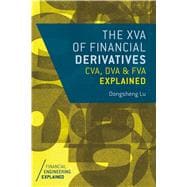This latest addition to the Financial Engineering Explained series focusses on the new standards for derivatives valuation, namely, pricing and risk management taking into account counterparty risk, and the XVA's – Credit, Funding and Debt value adjustments.
Written by practitioners with hands on experience in this field, it will provide a practical introduction to different valuation adjustment for derivative trading by first examining the various aspects of derivative trading business. The book then proceeds to explain what these adjustments (CVA, DVA, FVA) are and their impacts. Issues related modeling and implementation techniques will be discussed. The emphasis would be on giving a complete picture in a transparent manner, so that the reader can get a clear understanding of these practical valuation issues that are critical in pricing, trading and risk management of derivatives.
Written by practitioners with hands on experience in this field, it will provide a practical introduction to different valuation adjustment for derivative trading by first examining the various aspects of derivative trading business. The book then proceeds to explain what these adjustments (CVA, DVA, FVA) are and their impacts. Issues related modeling and implementation techniques will be discussed. The emphasis would be on giving a complete picture in a transparent manner, so that the reader can get a clear understanding of these practical valuation issues that are critical in pricing, trading and risk management of derivatives.








